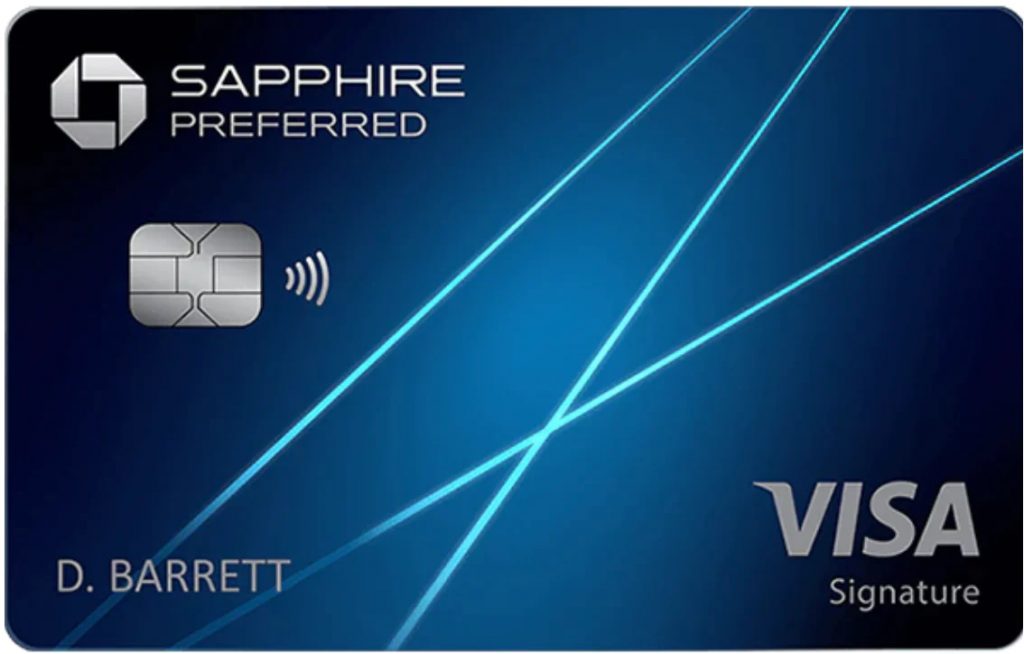Chase Sapphire Preferred® Card

The Chase Sapphire Preferred® Card is one of the best-known travel rewards credit cards, featuring 5 points per dollar on travel booked through the Chase travel portal and 3 points per dollar on dining, select streaming services and online grocery store purchases (excluding Target, Walmart and wholesale clubs). These valuable points can be transferred to airline and hotel partners or redeemed directly for travel at a rate of 1.25 cents per point through Chase Ultimate Rewards.
For an annual price tag of $95 you’ll earn 5 points per dollar on travel purchased through Chase Ultimate Rewards®, 3 points per dollar on dining, select streaming services, and online grocery purchases (excluding Walmart, Target and wholesale clubs), 2 points per dollar on all other travel purchases and 1 point per dollar on all other purchases.
With this card, you can redeem Ultimate Rewards® points strategically for travel, like transferring those points to a variety of loyalty programs, including United Airlines or Hyatt, for example.
Pros
- Earn high rewards on several areas of spending
- Transfer points to travel partners at 1:1 rate
- $0 foreign transaction fees
- Many travel and shopping protections
Cons
- $95 annual fee
- Requires good/excellent credit
- Complicated rewards
How It’s Compared
Chase Sapphire Preferred® Card vs. Chase Sapphire Reserve®
The Chase Sapphire Preferred® Card and the Chase Sapphire Reserve® are both excellent options for those looking to earn rewards and enjoy travel benefits. The key difference between them lies in their annual fees and the level of benefits they offer. The Chase Sapphire Preferred® Card has a lower annual fee ($95), making it a more budget-friendly choice for those who love to travel but don’t want to commit to a higher fee. It offers a solid sign-up bonus, 2x points on dining and travel, and great travel protection benefits.
On the other hand, the Chase Sapphire Reserve® comes with a higher annual fee ($550) but offers more premium perks. It offers a substantial annual travel credit, a higher earning rate for rewards, and additional benefits like Priority Pass lounge access and Global Entry/TSA PreCheck fee reimbursement. If you travel frequently and can take advantage of these perks, the Reserve might be a better choice despite the higher cost.
Chase Sapphire Preferred® Card vs. Capital One Venture Miles Rewards Credit Card
The Chase Sapphire Preferred® Card is known for its flexible Ultimate Rewards points, which can be transferred to various airline and hotel partners for potentially high redemption value. It offers bonus points on dining and travel expenses, as well as travel protections.
As with the Sapphire Preferred, the Venture card features a $95 annual fee. The Capital One Venture Miles Rewards Credit Card simplifies the earning and redemption process with a flat rate of 2x miles on all purchases, with no need to juggle cards. It doesn’t have the same level of transfer partners as the Sapphire Preferred, but it offers easy-to-redeem miles for any travel-related expenses.
If you prefer simplicity and don’t want to deal with complex points systems, the Venture card might be a better choice. However, the Sapphire Preferred can offer more value if you’re willing to put in the effort to maximize its rewards.
Chase Sapphire Preferred® Card vs. Citi Premier® Card
The key distinction between the two lies in their reward structures and partner programs. The Chase Sapphire Preferred® Card earns Ultimate Rewards points, which are highly flexible and can be transferred to various airline and hotel loyalty programs. It offers a strong bonus on dining and travel expenses and provides valuable travel insurance benefits.
Conversely, the Citi Premier® Card earns ThankYou Points, which can also be transferred to select travel partners, although the list is not as extensive as that of the Chase card. However, you’ll get a 3X rewards rate in categories like supermarket, gas station, restaurant and entertainment. If you dine out frequently or spend a lot on entertainment, the Citi Premier® Card might be the better option for you. The choice between these two cards depends on your spending habits and the specific travel partners you value.
Bottom Line
The Chase Sapphire Preferred is a terrific entry point into the world of travel rewards if you’re ready to move beyond cash-back or fixed-value credit card rewards. For a reasonable $95 annual fee, it offers exceptional value, simple redemption options, and premium benefits.
If you’re looking for ultra-swanky high-end perks, look at a different card and be prepared to pay the price. But for anyone seeking a comfortable way to accrue earnings they can use towards future trips, look no further than the Sapphire Preferred.
Transfer partners
There are a total of ten airline loyalty programs and three hotel loyalty programs that partner with Chase Ultimate Rewards®. Points for these programs can be transferred at a 1:1 ratio in increments of 1,000.
However, not all Chase travel partners are created equal. Programs such as IHG Rewards Club and Marriott Bonvoy offer less value than redeeming your points for cash or through Chase Travel, while most transfer partners offer much greater value.
Airline transfer partners
- Aer Lingus AerClub
- Air Canada Aeroplan
- BritishAirways Executive Club
- Emirates Skywards
- Flying Blue AIR FRANCE KLM
- Iberia Plus
- JetBlue TrueBlue
- Singapore Airlines KrisFlyer
- Southwest Airlines Rapid Rewards®
- United MileagePlus®
- Virgin Atlantic Flying Club
Hotel transfer partners
- IHG® Rewards Club
- Marriott Bonvoy™
- World of Hyatt®